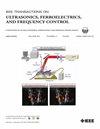A Fully Populated Transrectal Array for Boiling Histotripsy Ablation of the Prostate
IF 3.7
2区 工程技术
Q1 ACOUSTICS
IEEE transactions on ultrasonics, ferroelectrics, and frequency control
Pub Date : 2025-08-07
DOI:10.1109/TUFFC.2025.3596780
引用次数: 0
Abstract
The endorectal ultrasound (US)-guided thermal ablation of prostate cancer (PCa) using high-intensity focused ultrasound (HIFU) is a widely used focal intervention. While generally safe and effective, it is not without challenges associated with heat diffusion and prefocal heating, which has spurred interest toward nonthermal and mechanical HIFU ablation regimes. Another challenge is the necessity to mechanically translate the HIFU transducer—commonly single-element or annular array—for volumetric treatments, which results in target shifts and transducer position readjustment. The 2-D arrays would address this problem, but their design is challenging in a small form factor. The element pattern must be tightly packed and aperiodic to maximize the active surface area and to suppress grating lobes, respectively. Here, we report on the design, fabrication, and performance evaluation of a 1.5-MHz 128-element transrectal HIFU array driven by Verasonics system capable of mechanical tissue ablation via boiling histotripsy (BH) under real-time coaxial US imaging guidance. A recently developed method for designing randomized, fully populated mosaic arrays was used to create the element pattern. The measured focus steering ranges of the fabricated array were 26 mm axially and 12 mm laterally in the BH regime, with driving voltage compensation by less than 43% and no grating lobe formation. Stress tests with a five-element prototype confirmed safe operating voltage of 850-V peak-to-peak, corresponding to the acoustic intensity of 542 W/cm2 at the array surface. The array integrated with a 128-element US imaging probe driven by the same Verasonics system was successfully used to produce volumetric BH lesions in polyacrylamide (PAA) tissue-mimicking phantoms.经直肠沸腾组织切片消融的全填充阵列。
直肠内超声(US)引导下高强度聚焦超声(HIFU)热消融前列腺癌是一种广泛应用的病灶介入治疗方法。虽然它通常是安全有效的,但并非没有与热扩散和焦前加热相关的挑战,这激发了人们对非热机械HIFU消融方案的兴趣。另一个挑战是需要机械地转换HIFU换能器(通常是单元件或环形阵列)进行体积处理,这会导致目标位移和换能器位置重新调整。二维阵列可以解决这个问题,但它们的设计在小尺寸方面具有挑战性。元件图案必须紧密排列和非周期性,以最大限度地提高有效表面积和抑制光栅瓣。在这里,我们报告了由Verasonics系统驱动的1.5 mhz 128单元经直肠HIFU阵列的设计、制造和性能评估,该阵列能够在实时同轴US成像引导下通过沸腾组织切片(BH)进行机械组织消融。最近开发的一种设计随机、全填充马赛克阵列的方法被用来创建元素图案。测量结果表明,该阵列在BH区轴向聚焦范围为26 mm,横向聚焦范围为12 mm,驱动电压补偿小于43%,无光栅瓣形成。在5单元样机上进行的应力测试证实,安全工作电压为850 V,对应于阵列表面的声强为542 W/cm2。该阵列与由相同Verasonics系统驱动的128元US成像探针集成,成功地用于在聚丙烯酰胺组织模拟模型中产生体积BH病变。
本文章由计算机程序翻译,如有差异,请以英文原文为准。
求助全文
约1分钟内获得全文
求助全文
来源期刊
CiteScore
7.70
自引率
16.70%
发文量
583
审稿时长
4.5 months
期刊介绍:
IEEE Transactions on Ultrasonics, Ferroelectrics and Frequency Control includes the theory, technology, materials, and applications relating to: (1) the generation, transmission, and detection of ultrasonic waves and related phenomena; (2) medical ultrasound, including hyperthermia, bioeffects, tissue characterization and imaging; (3) ferroelectric, piezoelectric, and piezomagnetic materials, including crystals, polycrystalline solids, films, polymers, and composites; (4) frequency control, timing and time distribution, including crystal oscillators and other means of classical frequency control, and atomic, molecular and laser frequency control standards. Areas of interest range from fundamental studies to the design and/or applications of devices and systems.

 求助内容:
求助内容: 应助结果提醒方式:
应助结果提醒方式:


